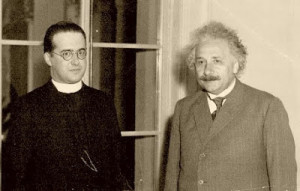Science Seen Physicist and Time One author Colin Gillespie helps you understand your world.
All One
The idea of the universe as a single thing has roots in ancient societies. It speaks to our existential questions: Where are we? What is our relation to the world? In the fifth century BCE, Zeno of Elea ponders whether the world is one thing or many. He says the concept of plurality is a contradiction.
If there are many things, it is necessary that they be just so many as they are and neither greater than themselves nor fewer. But if they are just as many as they are, they will be limited. If there are many things, the things that are are unlimited; for there are always others between these entities, and again others between those. And thus the things that are are unlimited.
 These days the Western worldview sees many things, not one. Yet even in the Western world the issue’s far from settled: In 1903, British philosopher Bertrand Russell calls Zeno’s Paradox of the One and the Many ‘immeasurably subtle and profound’. To this day it is embedded in our thoughts of time and space and motion. Russell says:
These days the Western worldview sees many things, not one. Yet even in the Western world the issue’s far from settled: In 1903, British philosopher Bertrand Russell calls Zeno’s Paradox of the One and the Many ‘immeasurably subtle and profound’. To this day it is embedded in our thoughts of time and space and motion. Russell says:
After two thousand years of continual refutation [Zeno’s] arguments were reinstated, and made the foundation of a mathematical renaissance.
By contrast with the Western view, many indigenous peoples see the world as one. This is easy to say but not so easy to do. It took me decades, thinking about stories told by elders of the Pimicikamak and Anishinaabe peoples, to see what they mean.
It seems easier to think of the world as one at its beginning. Whatever details one might have in mind (such as a sizeless singularity before the Big Bang) one can imagine it as single. Until, that is, that single thing splits into countless particles that make up billions of stars in each one of billions of galaxies. Where do they come from? Is this a shadow of the paradox that furrowed Zeno’s brow?
Many refutations of Zeno’s arguments hinge on the notion that space and time are continuous. These days, cutting-edge physics is exploring the idea they are not. Rather, space comes in tiny bits that cannot be divided. Time comes in tiny steps. Where does this leave Zeno? With One or with Many?
 Actually, both. We need language to discuss this. There is as yet no common term for the Planck-sized building block of space. I call it the fleck. Just as Belgian physicist Georges Lemaître (father of the Big Bang) said, in the beginning—i.e., before the Big Bang—there is just one fleck (a quantum that he called The Primeval Atom). It is the universe. It has a property Lemaître missed, that makes both space and all those particles: It replicates. Because the universe’s age is finite, there are finitely many flecks today.
Actually, both. We need language to discuss this. There is as yet no common term for the Planck-sized building block of space. I call it the fleck. Just as Belgian physicist Georges Lemaître (father of the Big Bang) said, in the beginning—i.e., before the Big Bang—there is just one fleck (a quantum that he called The Primeval Atom). It is the universe. It has a property Lemaître missed, that makes both space and all those particles: It replicates. Because the universe’s age is finite, there are finitely many flecks today.
Yet—Zeno might say and so would those elders—the world was one thing then; it is one thing now and we partake of it.
Many advanced courses in philosophy of space and time start with Zeno’s paradoxes. So they are in lots of course materials online. For example, a link below takes you to Physics 433 at Bowling Green State University. You will find that, with the fleck in mind, you can out-think Zeno and the course instructor.
Coming soon: The final atom.
Sources:
John Palmer (2012), “Zeno of Elea”, The Stanford Encyclopedia of Philosophy, Edward Zalta (ed.), http://plato.stanford.edu/archives/spr2012/entries/zeno-elea/
Bertrand Russell (1903), Principles of Mathematics, New York: Routledge, p. 352; https://archive.org/stream/principlesofmath005807mbp#page/n5/mode/2up
Other Reading:
Comer Duncan (1999), Physics and Philosophy of Space and Time, “The Birth of Rational Cosmology”, http://physics.bgsu.edu/~gcd/Spacetime3.html
Georges Lemaître (1946), L’Hypothese de L’Atome Primitif, Paris: Dunod; Betty H. Korff & Serge A. Korff (trs.) (1950), The Primeval Atom, New York: D. van Nostrand Company, Inc.; Preface by Ferdinand Gonseth, p. 12; http://www.scribd.com/doc/99059242/Lemaitre-The-Primeval-Atom-o
Colin Gillespie (2013), Time One: Discover How the Universe Began, New York: RosettaBooks, p. 313, http://www.rosettabooks.com/book/time-one/; “Gone Fizzion”, http://www.timeone.ca/chapters/gone-fizzion.pdf
Image Sources:
Ada Palmer (2014), “Sketches of a History of Skepticism”, Ex Urbe, http://www.exurbe.com/wp-content/uploads/2014/03/EpicureanMotion.jpg
Mercury (2010), “Georges Lemaître and the ‘Big Bang’ [aka ‘hypothesis of the primeval atom’]”, Philosophy of Science Portal, http://philosophyofscienceportal.blogspot.ca/2010/06/georges-lemaitre-and-big-bang-aka.html

No comments yet.